Find the best Warehouse Management Software (WMS)
Compare Products
Showing 1 - 20 of 418 products
Sort by
Reviews: Sorts listings by the number of user reviews we have published, greatest to least.
Sponsored: Sorts listings by software vendors running active bidding campaigns, from the highest to lowest bid. Vendors who have paid for placement have a ‘Visit Website’ button, whereas unpaid vendors have a ‘Learn More’ button.
Avg Rating: Sorts listings by overall star rating based on user reviews, highest to lowest.
A to Z: Sorts listings by product name from A to Z.
Shipedge
Shipedge
The Shipedge Platform was created to solve the challenges associated with the complete order management lifecycle and supporting activities. We’re dedicated to providing innovative solutions to make commerce easier and more connec...Read more about Shipedge
Leanafy
Leanafy
Leanafy WMS is a cloud-based solution that will help you manage your warehouse and inventory processes more efficiently. The solution provides real-time visibility into your orders, shipments, and inventory levels so that you can ...Read more about Leanafy
NetSuite
NetSuite
With an integrated system that includes ERP, financials, commerce, inventory management, HR, PSA, supply chain management, CRM and more – NetSuite enables fast-growing businesses across all industries to work more effectively by a...Read more about NetSuite
Excalibur WMS
Excalibur WMS
Excalibur WMS by Camelot 3PL is a cloud-based or on-premise warehouse management solution (WMS), designed exclusively for third-party logistics (3PL) warehouses and fulfillment operations. Excalibur is customizable for a variety o...Read more about Excalibur WMS
Talk with us for a free
15-minute consultationSoftware Advice is free because vendors pay us when they receive sales opportunities.
This allows us to provide comprehensive software lists and an advisor service at no cost to you.
This allows us to provide comprehensive software lists and an advisor service at no cost to you.
Meet Eric, a software expert who has helped 1,534 companies select the right product for their needs.
Talk with us for a free
15-minute consultationSoftware Advice is free because vendors pay us when they receive sales opportunities.
This allows us to provide comprehensive software lists and an advisor service at no cost to you.
This allows us to provide comprehensive software lists and an advisor service at no cost to you.
Tell us more about your business and an advisor will reach out with a list of software recommendations customized for your specific needs.
STEP 1 OF 4
How many employees are in your company?
Item
Item
Item is a cloud-based solution that helps streamline supply chain and warehouse management. In-depth, real-time visibility is at the heart of Item's features, providing a comprehensive view of warehouse activities, inventory, empl...Read more about Item
Tecsys Elite
Tecsys Elite
Tecsys’ Elite™ provides a series of cloud-based supply chain management solutions suitable for midsize to large distribution companies. The company currently services a wide range of verticals such as healthcare, service parts, he...Read more about Tecsys Elite
Agiliron
Agiliron
Agiliron is an all-in-one Retail Management System which allows you to manage all orders, inventory and CRM records, from all channels, in one place. Agiliron also integrates with many of your existing business tools like Quickb...Read more about Agiliron
WithoutWire
WithoutWire
The WithoutWire Inventory Platform WMS is built for complex inventory management. With one mobile app that can be deployed across iOS and Android platforms, rugged or consumer devices, our Inventory Platform WMS is easy to integra...Read more about WithoutWire
Kechie
Kechie
Kechie Distribution Management efficiently manages internal and external resources. Suited for growing businesses, the management tools provide control of replenishment, warehouse management, pick, pack, and ship, procurement, pro...Read more about Kechie
Avectous
Avectous
Avectous is a cloud-based warehouse management solution that helps businesses manage shipping, forecasting, slotting and other processes. The platform provides task-based management, kitting, and API integrations to optimize proce...Read more about Avectous
VeraCore
VeraCore
The VeraCore Fulfillment Solution was developed for leading 3PLs, order fulfillment companies, and online retailers. VeraCore is designed to be at the core of your fulfillment business. More than just pick & pack software, VeraCo...Read more about VeraCore
IntraOne WMS
IntraOne WMS
IntraOne WMS is an end-to-end warehousing and fulfillment execution platform. IntraOne WMS optimizes warehouse and operational processes, reduces labor costs, and increases order fulfillment throughput. In addition, IntraOne WMS s...Read more about IntraOne WMS
SAP S/4HANA Cloud
SAP S/4HANA Cloud
SAP S/4HANA Cloud is a cloud-based and on-premise enterprise resource planning (ERP) solution. It is suitable for small, midsize and large businesses in industries such as automotive, engineering, construction, mining, research an...Read more about SAP S/4HANA Cloud
ShipHawk
ShipHawk
At ShipHawk, we’re dedicated to improving and automating the world behind the buy button for growing companies. The reality today is that independent businesses must deliver on expectations set by the mega-retail giants and they h...Read more about ShipHawk
SOLOCHAIN WMS
SOLOCHAIN WMS
SOLOCHAIN WMS is a highly flexible and adaptive warehouse management system built for companies that need their supply chains to be nimble, efficient, and scaling, while ensuring execution excellence, compliance, and operational s...Read more about SOLOCHAIN WMS
proVision WMS
proVision WMS
Ahearn &Soper Inc. is a leading provider of supply chain technology to the warehouse, manufacturing, and healthcare industries throughout North America. The company’s portfolio includes software, hardware, supplies, and service. O...Read more about proVision WMS
Logiwa WMS
Logiwa WMS
Logiwa WMS is a cloud-based warehouse management and order fulfillment solution built on a .NET framework. The solution supports disparate warehousing processes, separate product groups and the needs of different sectors within a ...Read more about Logiwa WMS
Easy WMS
Easy WMS
Mecalux Easy WMS is a warehouse management solution that helps e-commerce manufacturers, distributors, and third-party logistics businesses automate the entire supply chain lifecycle, from order management to shipping. It enables ...Read more about Easy WMS
Da Vinci Supply Chain Business Suite
Da Vinci Supply Chain Business Suite
Da Vinci is a cloud-based supply chain management (SCM) solution designed specifically for 3PLs, internet retailers and wholesale businesses with demanding warehouse, fulfillment and transportation needs. In addition to a WMS an...Read more about Da Vinci Supply Chain Business Suite
Sphere WMS
Sphere WMS
SphereWMS warehouse management software optimizes workflow, direction, and processes at an operational level to increase efficiency and drive down costs for 3PL's, distribution, fulfillment, e-commerce, and retail operations. ...Read more about Sphere WMS
Popular Comparisons
Buyers Guide
Last Updated: March 16, 2023What is a warehouse management system?
A warehouse management system (WMS) is software made to help users improve the efficiency of tracking inventory and supplies as they move through a warehouse or distribution center. A WMS also makes certain processes, such as receiving, picking, and putting away products, faster and more accurate.
Benefits of warehouse management system
Warehouse management software, whether offered as a stand-alone service or as part of an enterprise resource planning (ERP) or supply chain management (SCM) suite, can significantly enhance processes. For example, most WMS software will help you:
Optimize tasks. Many WMS vendors offer options to reduce human error and speed up common warehouse operations. For example, barcoding or RFID scanning can make sorting, counting, picking, and receiving a breeze.
Save money. By incorporating reporting tools such as demand forecasting and vendor-managed inventories, a WMS can ensure no products are going to waste.
Better serve customers. Possibly the biggest benefits of a well-managed warehouse is the relationship between suppliers and buyers. WMS software can cut down picking, packaging, and shipping times. This will result in customers receiving purchases sooner and being happier with the process overall.
Competitive advantages of using warehouse management software
By automating fundamental warehouse operations, WMS software can give you a competitive edge over other businesses in your market. You can:
Grow your business: The bigger your business gets, the more you'll have to keep track of. That can become troublesome when you lack a standardized, easy-to-use tool for regulating your warehouse, and that alone makes investing in a scalable WMS the smart choice.
Boost productivity: By helping you determine what works for your product and your employees, warehouse software can save your team time, which will in turn save you money and enhance morale on the floor.
Increase transparency: Customizable reporting tools can give you a much clearer and broader view of your product, helping you plan ahead to meet demands as well as reducing miscommunication between you and your customers.
Business sizes using warehouse management software
Most warehouse management vendors price their software in tiered modules. Besides determining whether you want to pay a subscription fee or purchase a perpetual license (more on that later), you'll need to determine which of the following categories you fall into:
Small business. This tier may also be referred to as a “starter package," but it will always be the entry-level package. Typically, starter modules cater to businesses with fewer than 50 employees and between one and five users. More advanced features may not be available in this price range, but smaller businesses usually won't miss those features.
Midsize. This applies to businesses with anywhere from 50 to 500 employees and around 10 software users; such businesses often have multiple locations for which to coordinate stock levels. This is often the highlighted package because you get the most features for the lowest cost, but you'll want to weigh functionality against your other options very carefully here.
Enterprise. These are large and/or multiple warehouses with thousands of employees and as many as 100 users at a time. You'll get the full range of features at this tier, and you may start to see user minimums crop up in these pricing ranges.
Features guide
A list of common warehouse management features
When researching warehouse management software, it's important to know what features and functionality you'll be looking for. We've provided a table with the most common WMS features below.
Warehouse design | Enables customization so that users can distribute things like workloads and bin space adequately. |
Inventory tracking | Barcoding or other scanning systems cut down on the amount of human error involved in moving or storing product. |
Receiving and putaway | Clearly mark and record where every item is stored so you don't waste time searching for it when picking. |
Pick-and-pack | Cut down on workload by eliminating extra trips to pick product because you'll know right where everything is at all times. |
Shipping | Automatically generate labels, forms, or assembly instructions to ship with the product. |
Reporting | Provides a snapshot of the warehouse floor at any given moment. Customizable to enable users to see the whole picture or just a part of it. |
Features details and examples
Warehouse design. This functionality allows users to customize workflow and picking logic to ensure that inventory is allocated to the correct location within each facility. The WMS establishes correct bin slotting to maximize warehouse space and account for seasonal inventory variance.
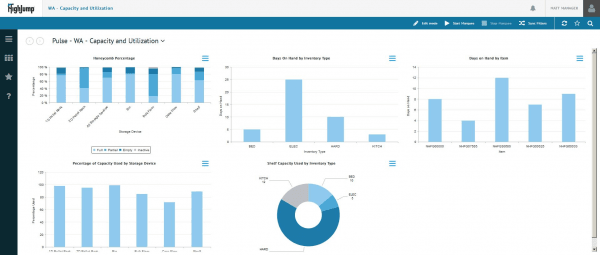
HighJump Warehouse Advantage capacity and utilization dashboard
Inventory tracking. Most systems offer the ability to use advanced tracking systems, such as auto ID data capture (AIDC), barcode scanners or radio-frequency identification (RFID) to ensure that inventory is correctly logged and easily located when the time comes for it to move.

Barcoding functionality offered by 3PL Warehouse Manager
Receiving and putaway. Once inventory is logged, warehouse management systems assist with inventory putaway for retrieval at a later date. More advanced systems offer pick-to-light (light-picking) and pick-to-voice (voice-picking) technology to aid more sophisticated warehouse environments.
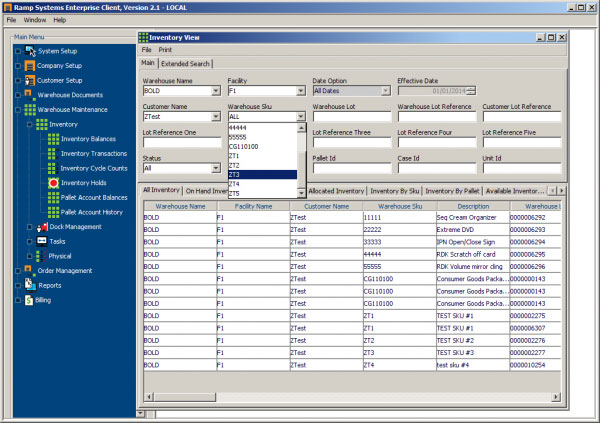
Inventory control with searchable SKU, pallet, and lot options by Ramp Systems' Enterprise WMS
Pick-and-pack. Warehouse management systems often contain a variety of options like zone picking, wave picking and batch picking to provide managers greater flexibility. Additionally, lot zoning and task interleaving help workers reduce the number of trips necessary to complete a task.
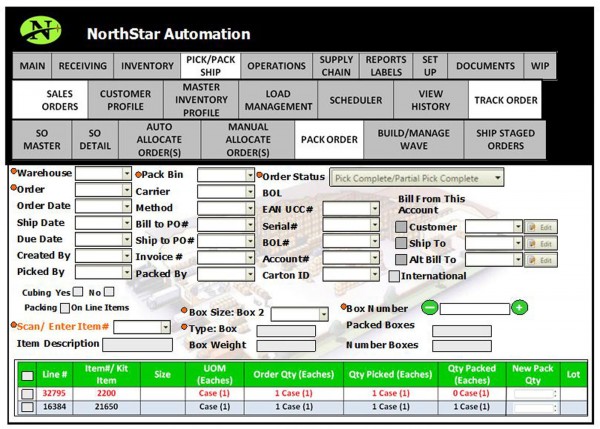
Pick, pack, & ship within NorthStar WMS
Shipping. Once inventory is packed, the WMS can send itemized bills of lading (B/L) ahead of the shipment, generate packing lists and invoices for buyers to reconcile items shipped with items ordered, and even include assembly instructions if needed. Once items have been packed, the warehousing software can send advanced shipment notifications (ASN) to notify other facilities of pending deliveries.
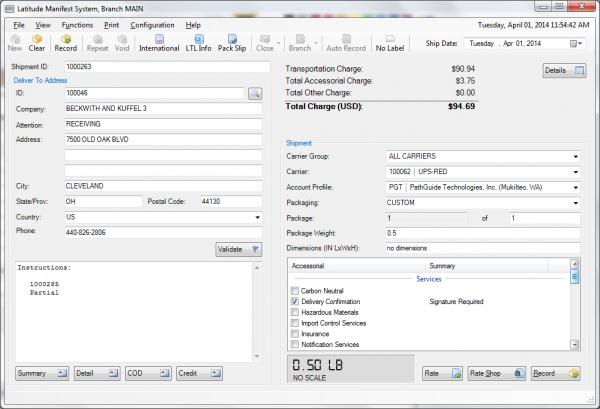
Automated shipment information in PathGuide's Latitude WMS
Reporting. Advanced reporting features within the software can help managers analyze the performance of the operation as a whole and find areas for improvement. For example, the system can automatically analyze cycle counts, which track a different subset of inventory each day.
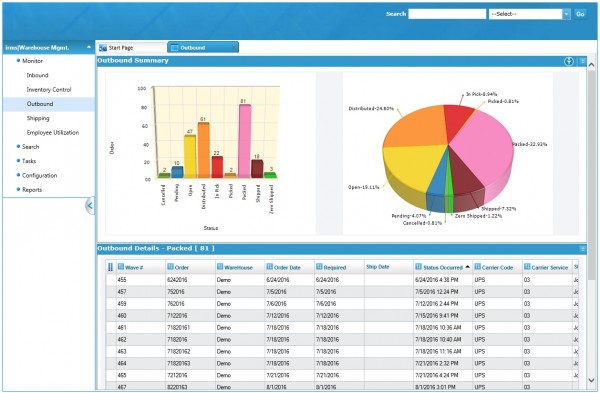
Reporting functionality in Aptean WMS
Warehouse management buyers' top-requested features
We took a random sample of 385 business leaders who reached out to Software Advice in the past 12 months for help picking out warehouse management software to determine which features they want most. As inventory tracking is the backbone of a WMS, we excluded it and counted the next most requested functionality.
We found that pick, pack, and ship and scanning were far and away the most popular. Receiving and location tracking features are also very popular. But it should be noted that scanning and pick, pack, and ship are common functions in a warehouse and they could have been assumed as a needed functionality.
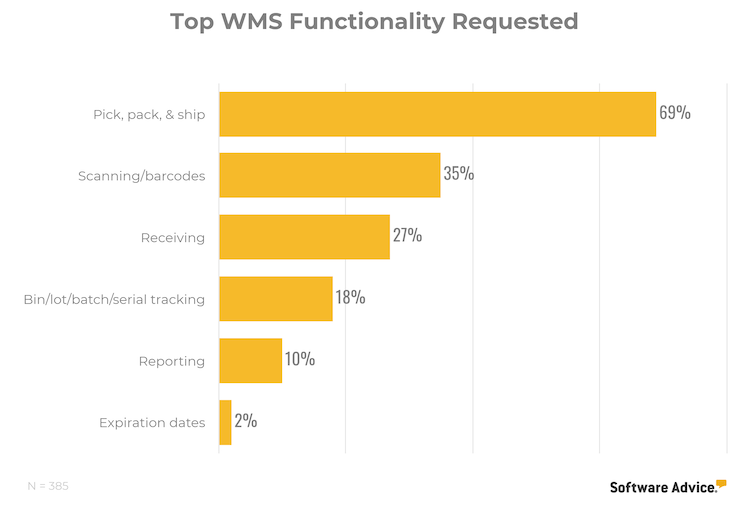
The above are the common functionality of WMSs, but it's important to know that WMS vendors are prepared to cater to much more complex warehouse needs. For example, iIn Gartner's 2019 Magic Quadrant for WMS, Gartner says the “extended WMS capabilities are value-added capabilities that supplement core functions, such as labor management, slotting, yard management and dock scheduling." (Full report available to Gartner clients only.)
Pricing Guide
To learn how warehouse management software is priced and deployed, check out our most recent pricing guide.
FAQs
What are the key functions of a warehouse management system?
As we mentioned in the “Benefits of Warehouse Management Software" section, there are a number of advantages to using a WMS.
Improved inventory visibility. You can track product location to speed up order fulfillment and putaways, track expiration dates to reduce product loss, and view real-time stock levels via software dashboards.
Optimized tasks and workflow. Through the use of workforce management, barcoding hardware, item tracking, automated picking instructions, and so many other features, your warehouse processes will run smoother and you, your employees, your suppliers, and your customers will be happier.
Money saved by reducing waste and error. Less wasted time on numerous picking runs to the same bin, less expired or lost products going to waste on the shelf, and less human error throwing monkey wrenches in daily operations.
Happy customers. Through transparent product availability and faster shipping and delivery times, you have the power to please your customers and create loyal and lasting patrons.
Important questions to ask vendors when evaluating warehouse management software
One thing you're sure to notice when researching WMS software is that the amount of information provided on easily-accessible websites is limited. That's okay, though, because you can always request a demo to have a representative walk you through the product and talk through anything you don't understand.
That said, you shouldn't just rely on the representative to tell you everything. Here are a few questions you may want to ask during the demo:
Does this system offer industry-specific functionality for the unique needs of your operation?
Support for first in/first out (FIFO) or kitting would be examples of this. If the answer is no, you'll want to follow up by asking whether or not the system can be configured to meet your market-specific needs.
What deployment model does this system follow?
In general, WMS software is available in one of two ways: through an on-premise deployment or cloud-based software. You'll want to consider the pros and cons of both to figure out which works best for you. Consider things like pricing models (typically, a one-time fee for on-premise deployment or a subscription-based fee for cloud-based systems) and the amount of hardware and support the system requires.
Will this system grow with your business?
As your company assumes more inventory and expands operations, you'll probably want to be able to add features to your existing software. Now's the time to find out if there will be any hidden fees or challenges when that time comes.
How much support will the vendor offer after you purchase their software?
Some vendors include regular upkeep in the initial purchase or subscription price. Others require you to schedule maintenance and pay extra for those services as-needed.
What kind of cross-functionality does this WMS offer?
You'll want to consider any integrations between this new system and your existing logistics solutions, such as transportation management systems or order fulfillment systems. For example, does this new system offer consolidated purchase reporting to help you keep track of expenses and accounting throughout the year?
Will the WMS user interface be easy to learn?
Training the team to use the new software is a frequently overlooked hurdle when it comes to adopting a new system, and you should absolutely ask what kind of experiences other buyers have had learning this system. You may also want to know if the vendor offers training sessions or walkthroughs to help introduce their software to a warehouse.
What are some drawbacks I should watch out for?
While vendors have become more competitive with their pricing, there's no avoiding the fact that a new warehouse management system will cost you a pretty penny. The bright side here is that you have plenty of options when it comes to choosing the best price and functionality, and the money you save after implementing your new WMS can start to make up for the cost pretty quickly.
Another thing to bear in mind when shopping around is that, though a quality WMS can help solve a lot of problems on the warehouse floor, it won't do any good if users don't know how to take advantage of every feature it offers. Take the time to learn everything you can about a new system and then make sure your employees are thoroughly trained on how to operate it.
Relevant articles
Here are some handy articles about WMS you should check out:
Recent events in the warehouse management market
For the 11th consecutive time, Manhattan Associates named category leader in Gartner's most recent Magic Quadrant. They've been identified as having a complete vision for their WMS and the highest ability to execute. For you, this means that even if you don't plan to use their software it's an excellent tool to compare your options against. Here's the press release. The full report on the Magic Quadrant is available to Gartner clients only.
FedEx will start shipping seven days a week in 2020. To keep up with consumer demand for faster shipping, FedEx will add year-round Sunday deliveries starting next January. If FedEx is your 3PL partner, or if you've been thinking about using them, now would be a good time to review your delivery strategy to take advantage of their new schedule.
Waymo to resume testing autonomous trucks in Arizona. The push for a trucking revolution continues! Waymo is only testing the self-driving trucks at this time and each truck has two drivers onboard at all times. But this does indicate that parent company, Alphabet (also Google's parent company), is betting on autonomous trucking being the way of the future. Self-driving trucks hypothetically will reduce shipping costs and increase speed of delivery—some things to look forward to.
Software related to warehouse management systems
Warehouse management often includes integrations with other enterprise resource or supply chain planning software. When searching for a new WMS, you may want to be aware of the following types of software:
Inventory management helps businesses with large volumes of physical products keep track of those products throughout the supply chain. This software includes features such as product categorization, sales and purchase order tracking, electronic scanning, and automatic ordering.
Third-party logistics software is specialized warehouse management and transportation software designed for the needs of logistics providers. It enables billing for warehouse storage space by a number of different metrics (a crucial feature for 3PLs) and offers special transportation management features such as support for parcel carriers.
Order management software allows businesses to capture sales orders from e-commerce and point of sale systems and optimize order fulfillment with algorithms. It's particularly useful for multichannel and e-commerce retailers, as well as large retailers with multiple branches.
Distribution software is required by a wide variety of businesses that operate in the middle of the supply chain between manufacturers and customers. Distribution software can feature a wide variety of functionality, including inventory management, warehouse management, customer management, order management, and accounting.
Manufacturing software provides functionality to plan and execute projects from beginning to end, while automating materials planning, production tracking and scheduling, and product lifecycle management.







